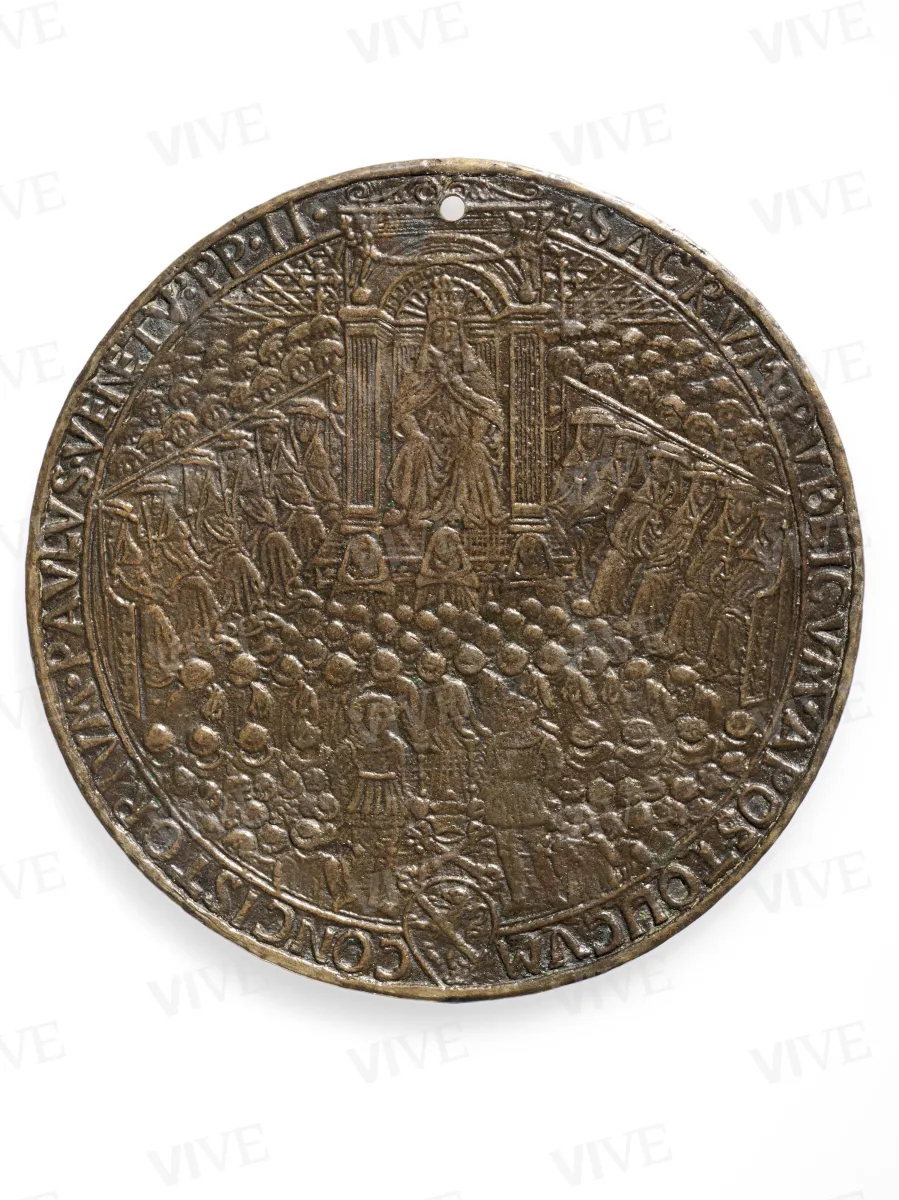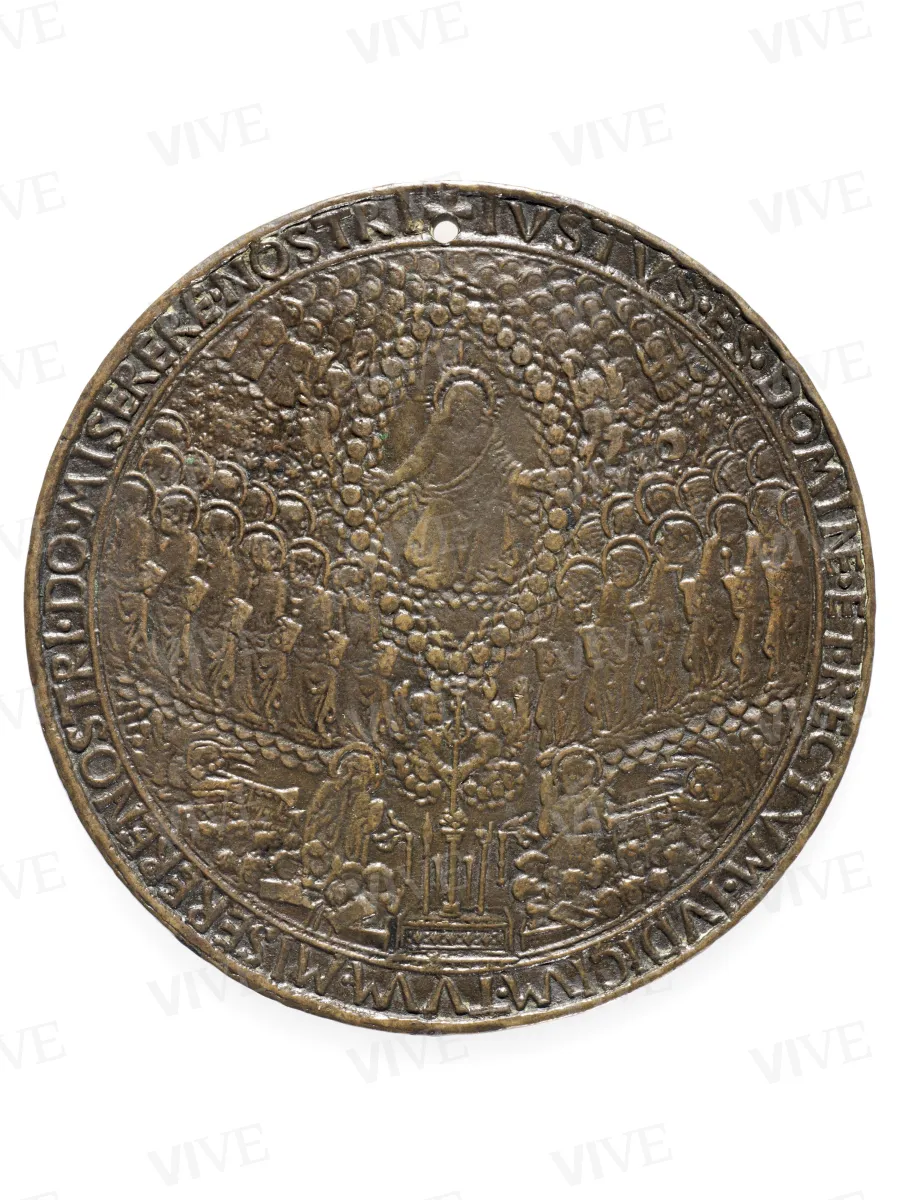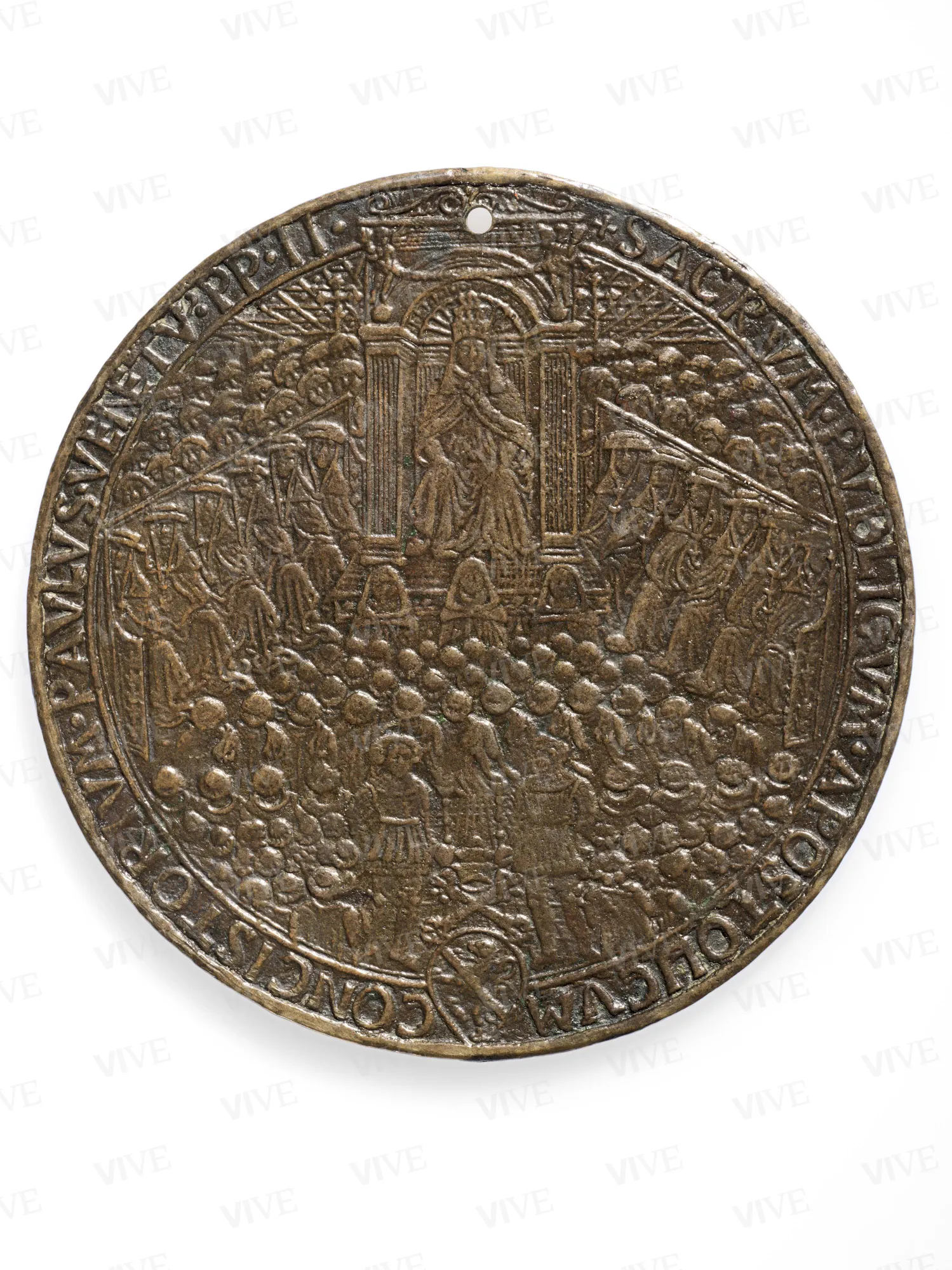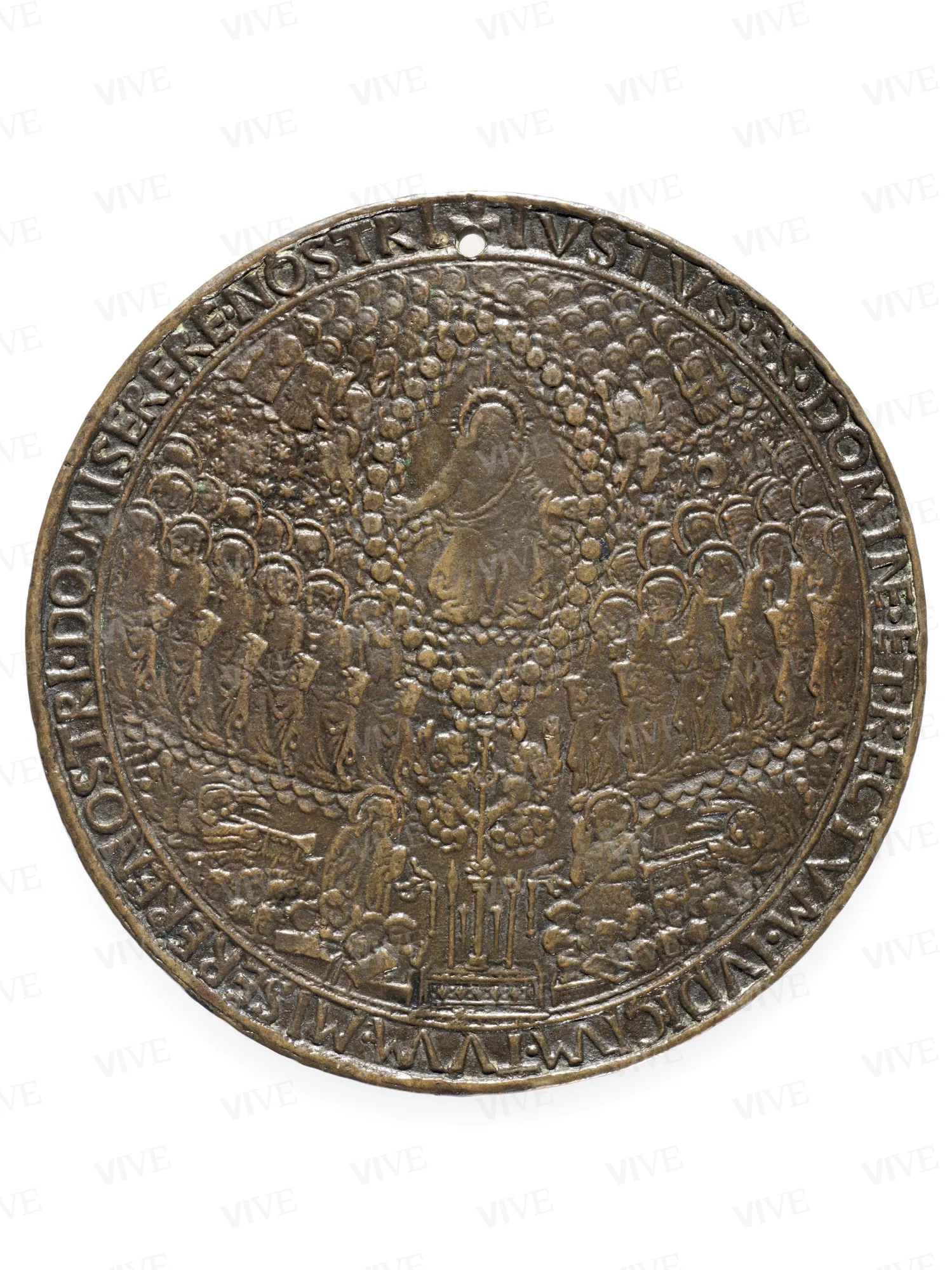Medal with Pope Paul II in consistory/Last Judgment
Emiliano Orfini 1466–1467
The large medal features a depiction of a consistory of Pope Paul II on one side and the Last Judgment on the other. It was cast by the papal engraver Emiliano Orfini using a specialized technique involving engraving a pair of pincers in negative to create wax models in positive for casting. This medal likely commemorates the consistory of 23 December 1466, when Pope Paul II excommunicated King George of Poděbrady of Bohemia for heresy.
The large medal features a depiction of a consistory of Pope Paul II on one side and the Last Judgment on the other. It was cast by the papal engraver Emiliano Orfini using a specialized technique involving engraving a pair of pincers in negative to create wax models in positive for casting. This medal likely commemorates the consistory of 23 December 1466, when Pope Paul II excommunicated King George of Poděbrady of Bohemia for heresy.
Details of work
Catalog entry
This large medal features, on its obverse, an image of Pope Paul II, who began his reign in 1464, presiding over a consistory. The pontiff is depicted wearing the papal tiara with long infules and a large cope fastened at the chest by a gemmed button, seated on a high throne ending in a round arch adorned with a shell and two winged cherubs holding a festoon. Surrounding him are twelve cardinals, each donning a galero (a type of hat), with rows of spectators positioned behind them. In front of the pope stands a congregation of religious figures, with two pages prominently positioned in the foreground holding the Barbo shield. The shield features a lion rampant facing left, crossed by a diagonal band, and topped by crossed keys surmounted by a tiara.
On the reverse side, there is a depiction of the Last Judgment. Christ is seated in heaven within a mandorla, surrounded by hosts of angels. Below this scene are the Doctors of the Church, the Madonna, and St John the Baptist positioned on either side of an altar adorned with symbols of the Passion. Finally, the dead are resurrected at the sound of trumpets played by angels. The consistory for which the medal was crafted likely took place on 23 December 1466, when Paul II excommunicated George of Poděbrady, King of Bohemia, who was accused of heresy and leading the religious reform movement known as Hussitism (Buonanni 1699, pp. 76–81, n. VII; Modesti 2002, pp. 265–266, n. 95). However, Paul II called another consistory in the spring of the following year, making it difficult to determine the exact occasion for which the medal was created. Consequently, its creation is cautiously dated between late 1466 and early 1467 (Pollard, Luciano 2007, I, pp. 264–265, n. 245).
Initially attributed to the engraver Andrea di Niccolò da Viterbo (Hill 1930, I, pp. 201–202, n. 775), the model for this medal has been accurately identified as the work of the Umbrian artist Emiliano Orfini. This conclusion is based on a stylistic analysis comparing it to coins signed by Orfini during his tenure at the papal mint, where he produced both currency and seals for the Pope (Weiss 1958, pp. 58–59). To further explain the intricate composition of the medal's two sides, which are more elaborate than Orfini's typical coin and seal designs (inv. 12431), a comparison has been made with a miniature by Jean Fouquet from about a decade earlier. Created during Fouquet’s time in Rome at the court of Pope Eugene IV, this miniature is currently housed at the Musée Condé in Chantilly (Waldman 1992). The similar scene layout, featuring diagonally arranged onlookers, indicates that the Foligno engraver likely had access to the French miniature.
Emiliano Orfini, born in Foligno to a family of goldsmiths and printers, served as a papal mintsman in Spoleto before relocating to Rome. Documented in Rome from at least 1464, Orfini secured a contract for the papal mint starting in 1471 for a minimum duration of five years. Besides engraving dies and seals for the Pope, Orfini also produced movable type for printing. Several incunabula attributed to him are still preserved (Scapecchi 2013).
There has been extensive debate regarding the technique used to manufacture this medal. Initially believed to be minted, due to its thin and clear relief without undercuts, which is characteristic of minted coins, it has also been identified in its pure gold versions as being equivalent to twenty papal ducats (Weiss 1961, p. 12, note 4). However, recent technical studies have traced the medal back to the casting technique. This explains the very low relief and aligns with the working method of Orfini, who, as a seal engraver, would have created a double-sided mold from which wax models could be cast in metal (Villani 2020).
Giulia Zaccariotto
Entry published on 27 March 2025
State of conservation
Good.
Inscriptions
Obverse: [within the roundel, within a double smooth border] “[cross] SACRVM • PVBLICVM • APOSTOLICVM [Barbo coat of arms] CONCISTORIVM • PAVLVS • VENETV[s] • P[a]P[a] • II •”
Reverse: [within a circle, within a double smooth border] “[cross] IVSTVS • ES • DOMINE • ET • RECTVM • IVDICIVM • TVVM • MISERERE • NOSTRI • DO[mine] • MISERERE • NOSTRI”
Provenance
Purchased by the Ministry from P&P Santamaria in 1975.
References
Buonanni Filippo, Numismata Pontificum Romanorum quae a tempore Martini V usque ad annum MDCXCIX vel authoritate publica, vel privato genio in lucem prodiere, Romae 1699;
Hill George Francis, A Corpus of Italian Medals of the Renaissance before Cellini, 2 voll., London 1930;
Weiss Roberto, Un umanista veneziano. Papa Paolo II, Venezia 1958;
Weiss Roberto, The Medals of Pope Sixtus IV (1471-1484), Roma 1961;
Balbi De Caro Silvana, Le medaglie del Museo del Palazzo di Venezia in Roma, in «Medaglia», I, 1971, 2, pp. 7-15;
Waldman Louis Alexander, A Medal of Paul II after a Design by Fouquet, in «The Medal», 1992, 21, pp. 3-15;
Modesti Adolfo, Corpus numismatum omnium Romanorum Pontificum. I. Da San Pietro (42-67) a Adriano VI (1522-1523), Roma 2002;
Pollard John Graham, Luciano Eleonora, Renaissance Medals, 2 voll., Washington DC 2007;
Scapecchi Piero, Emiliano Orfini, ad vocem, in Dizionario Biografico degli Italiani, LXXIX, Roma 2013.
Villani Rosa Maria, La medaglia di Paolo II in concistoro: ipotesi di tecnica esecutiva, in Simonato Lucia (a cura di), La collezione di medaglie Mario Scaglia. Esercizi di lettura, Bologna-Cinisello Balsamo 2020, pp. 192-193, n. 2;
Zaccariotto Giulia, La collezione di medaglie Mario Scaglia.II. Catalogo, Bologna-Cinisello Balsamo 2020, p. 119, n. 92.














